Integrated Case Study Analysis: NS2881 Nursing Practice 3 Assessment
VerifiedAdded on 2021/06/14
|6
|2115
|500
Case Study
AI Summary
This case study, prepared by a nursing student, presents a detailed nursing care plan for a 25-year-old patient, Mr. Davis, admitted to the orthopaedic unit following a motor vehicle accident. The assignment focuses on two primary nursing problems: dehydration and pain management. It outlines specific nursing goals, interventions with rationales, and expected health outcomes for each problem. The care plan includes monitoring vital signs, fluid balance, skin turgor, and IV therapy for dehydration, and pain assessment, the RICE technique, and drug therapy for pain management. The study emphasizes the application of Nursing and Midwifery Board Australia (NMBA) standards to ensure quality and safe patient care. The student justifies the chosen interventions based on evidence-based practice and relevant literature, including the importance of documentation and communication within the healthcare team. The case study concludes by highlighting the importance of following evidence-based pathways to ensure effective and safe nursing care, emphasizing the significance of NMBA standards in guiding practice and promoting patient-centered care. The paper also includes a comprehensive reference list.
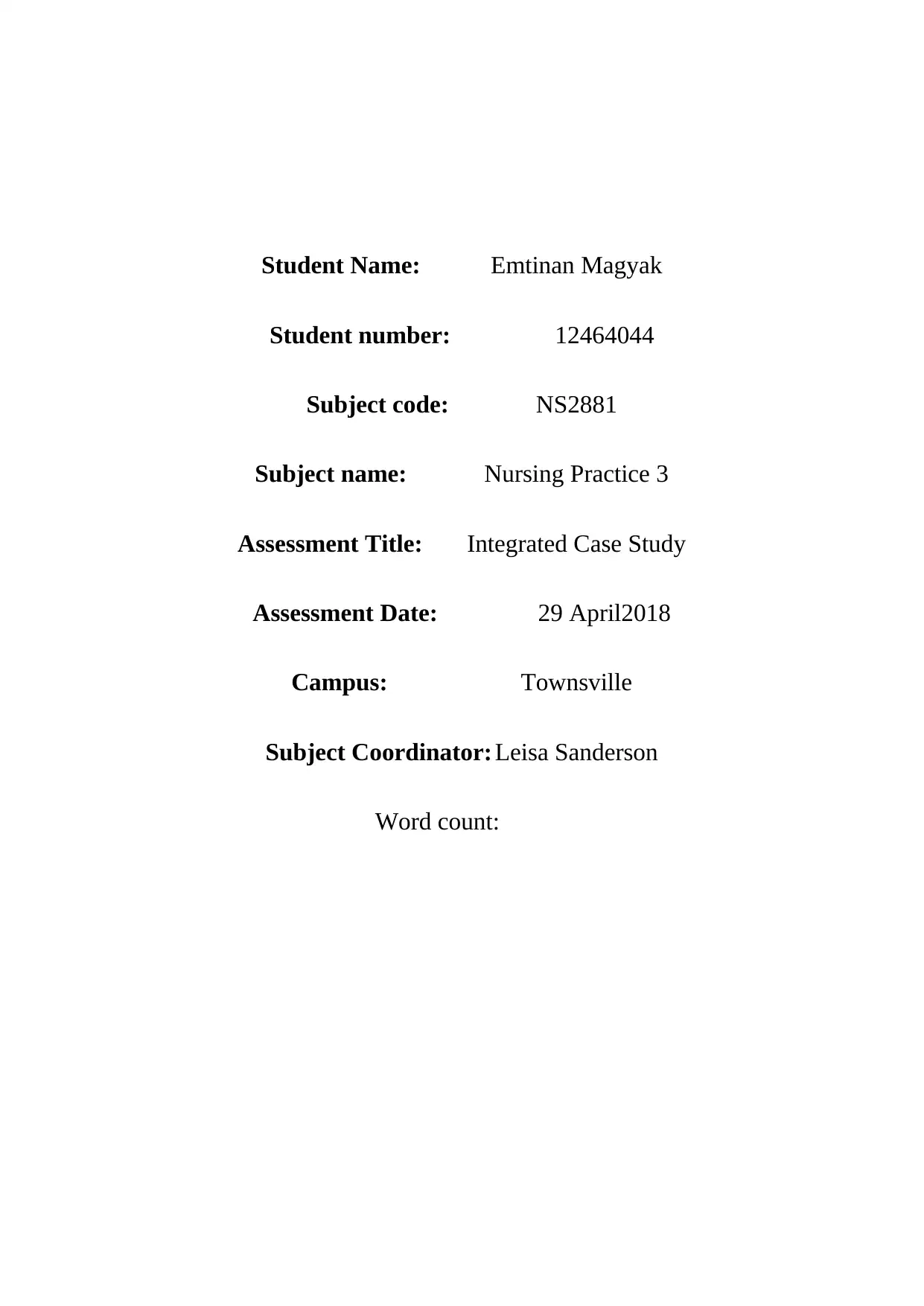
Student Name: Emtinan Magyak
Student number: 12464044
Subject code: NS2881
Subject name: Nursing Practice 3
Assessment Title: Integrated Case Study
Assessment Date: 29 April2018
Campus: Townsville
Subject Coordinator: Leisa Sanderson
Word count:
Student number: 12464044
Subject code: NS2881
Subject name: Nursing Practice 3
Assessment Title: Integrated Case Study
Assessment Date: 29 April2018
Campus: Townsville
Subject Coordinator: Leisa Sanderson
Word count:
Paraphrase This Document
Need a fresh take? Get an instant paraphrase of this document with our AI Paraphraser
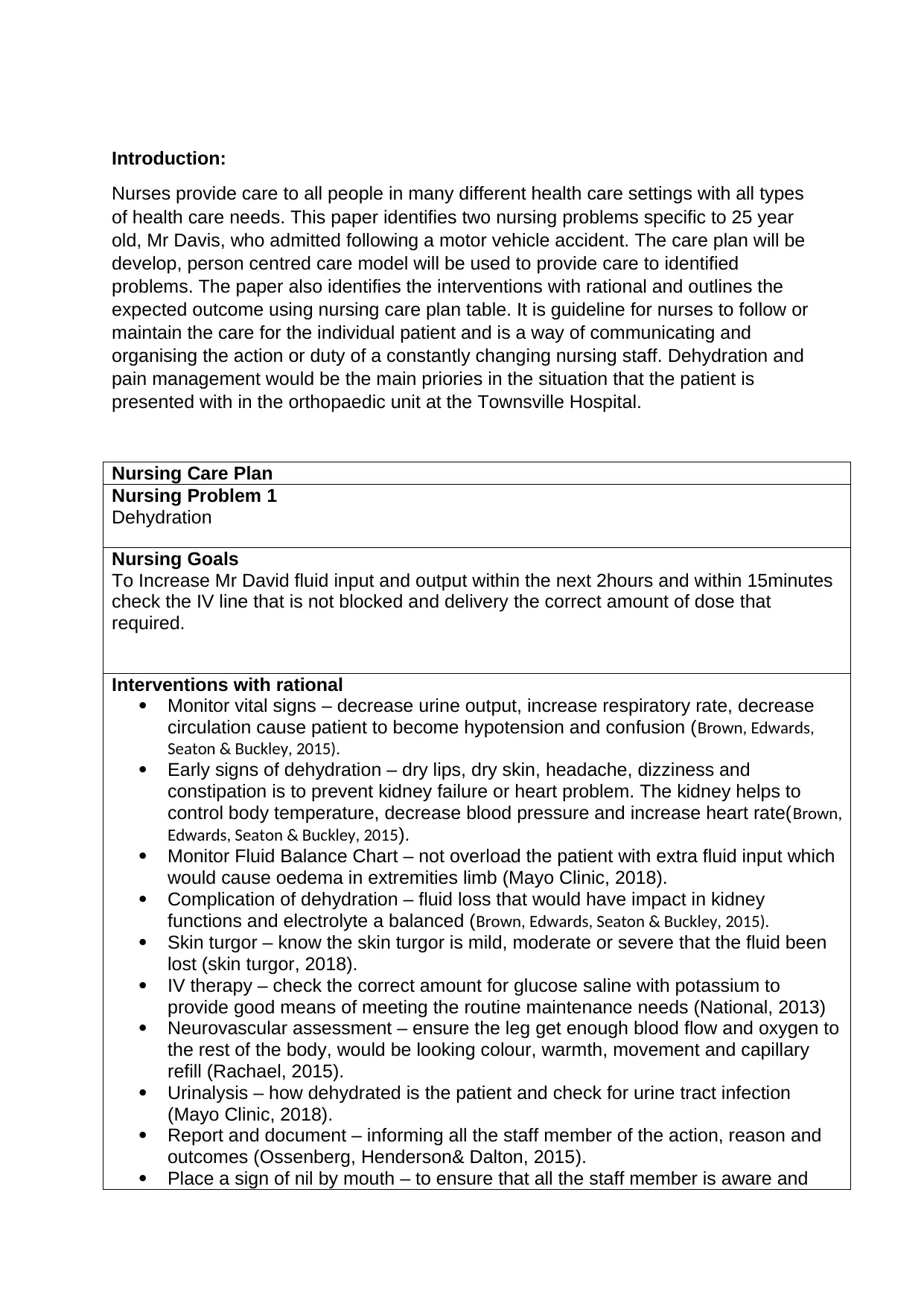
Introduction:
Nurses provide care to all people in many different health care settings with all types
of health care needs. This paper identifies two nursing problems specific to 25 year
old, Mr Davis, who admitted following a motor vehicle accident. The care plan will be
develop, person centred care model will be used to provide care to identified
problems. The paper also identifies the interventions with rational and outlines the
expected outcome using nursing care plan table. It is guideline for nurses to follow or
maintain the care for the individual patient and is a way of communicating and
organising the action or duty of a constantly changing nursing staff. Dehydration and
pain management would be the main priories in the situation that the patient is
presented with in the orthopaedic unit at the Townsville Hospital.
Nursing Care Plan
Nursing Problem 1
Dehydration
Nursing Goals
To Increase Mr David fluid input and output within the next 2hours and within 15minutes
check the IV line that is not blocked and delivery the correct amount of dose that
required.
Interventions with rational
Monitor vital signs – decrease urine output, increase respiratory rate, decrease
circulation cause patient to become hypotension and confusion (Brown, Edwards,
Seaton & Buckley, 2015).
Early signs of dehydration – dry lips, dry skin, headache, dizziness and
constipation is to prevent kidney failure or heart problem. The kidney helps to
control body temperature, decrease blood pressure and increase heart rate(Brown,
Edwards, Seaton & Buckley, 2015).
Monitor Fluid Balance Chart – not overload the patient with extra fluid input which
would cause oedema in extremities limb (Mayo Clinic, 2018).
Complication of dehydration – fluid loss that would have impact in kidney
functions and electrolyte a balanced (Brown, Edwards, Seaton & Buckley, 2015).
Skin turgor – know the skin turgor is mild, moderate or severe that the fluid been
lost (skin turgor, 2018).
IV therapy – check the correct amount for glucose saline with potassium to
provide good means of meeting the routine maintenance needs (National, 2013)
Neurovascular assessment – ensure the leg get enough blood flow and oxygen to
the rest of the body, would be looking colour, warmth, movement and capillary
refill (Rachael, 2015).
Urinalysis – how dehydrated is the patient and check for urine tract infection
(Mayo Clinic, 2018).
Report and document – informing all the staff member of the action, reason and
outcomes (Ossenberg, Henderson& Dalton, 2015).
Place a sign of nil by mouth – to ensure that all the staff member is aware and
Nurses provide care to all people in many different health care settings with all types
of health care needs. This paper identifies two nursing problems specific to 25 year
old, Mr Davis, who admitted following a motor vehicle accident. The care plan will be
develop, person centred care model will be used to provide care to identified
problems. The paper also identifies the interventions with rational and outlines the
expected outcome using nursing care plan table. It is guideline for nurses to follow or
maintain the care for the individual patient and is a way of communicating and
organising the action or duty of a constantly changing nursing staff. Dehydration and
pain management would be the main priories in the situation that the patient is
presented with in the orthopaedic unit at the Townsville Hospital.
Nursing Care Plan
Nursing Problem 1
Dehydration
Nursing Goals
To Increase Mr David fluid input and output within the next 2hours and within 15minutes
check the IV line that is not blocked and delivery the correct amount of dose that
required.
Interventions with rational
Monitor vital signs – decrease urine output, increase respiratory rate, decrease
circulation cause patient to become hypotension and confusion (Brown, Edwards,
Seaton & Buckley, 2015).
Early signs of dehydration – dry lips, dry skin, headache, dizziness and
constipation is to prevent kidney failure or heart problem. The kidney helps to
control body temperature, decrease blood pressure and increase heart rate(Brown,
Edwards, Seaton & Buckley, 2015).
Monitor Fluid Balance Chart – not overload the patient with extra fluid input which
would cause oedema in extremities limb (Mayo Clinic, 2018).
Complication of dehydration – fluid loss that would have impact in kidney
functions and electrolyte a balanced (Brown, Edwards, Seaton & Buckley, 2015).
Skin turgor – know the skin turgor is mild, moderate or severe that the fluid been
lost (skin turgor, 2018).
IV therapy – check the correct amount for glucose saline with potassium to
provide good means of meeting the routine maintenance needs (National, 2013)
Neurovascular assessment – ensure the leg get enough blood flow and oxygen to
the rest of the body, would be looking colour, warmth, movement and capillary
refill (Rachael, 2015).
Urinalysis – how dehydrated is the patient and check for urine tract infection
(Mayo Clinic, 2018).
Report and document – informing all the staff member of the action, reason and
outcomes (Ossenberg, Henderson& Dalton, 2015).
Place a sign of nil by mouth – to ensure that all the staff member is aware and
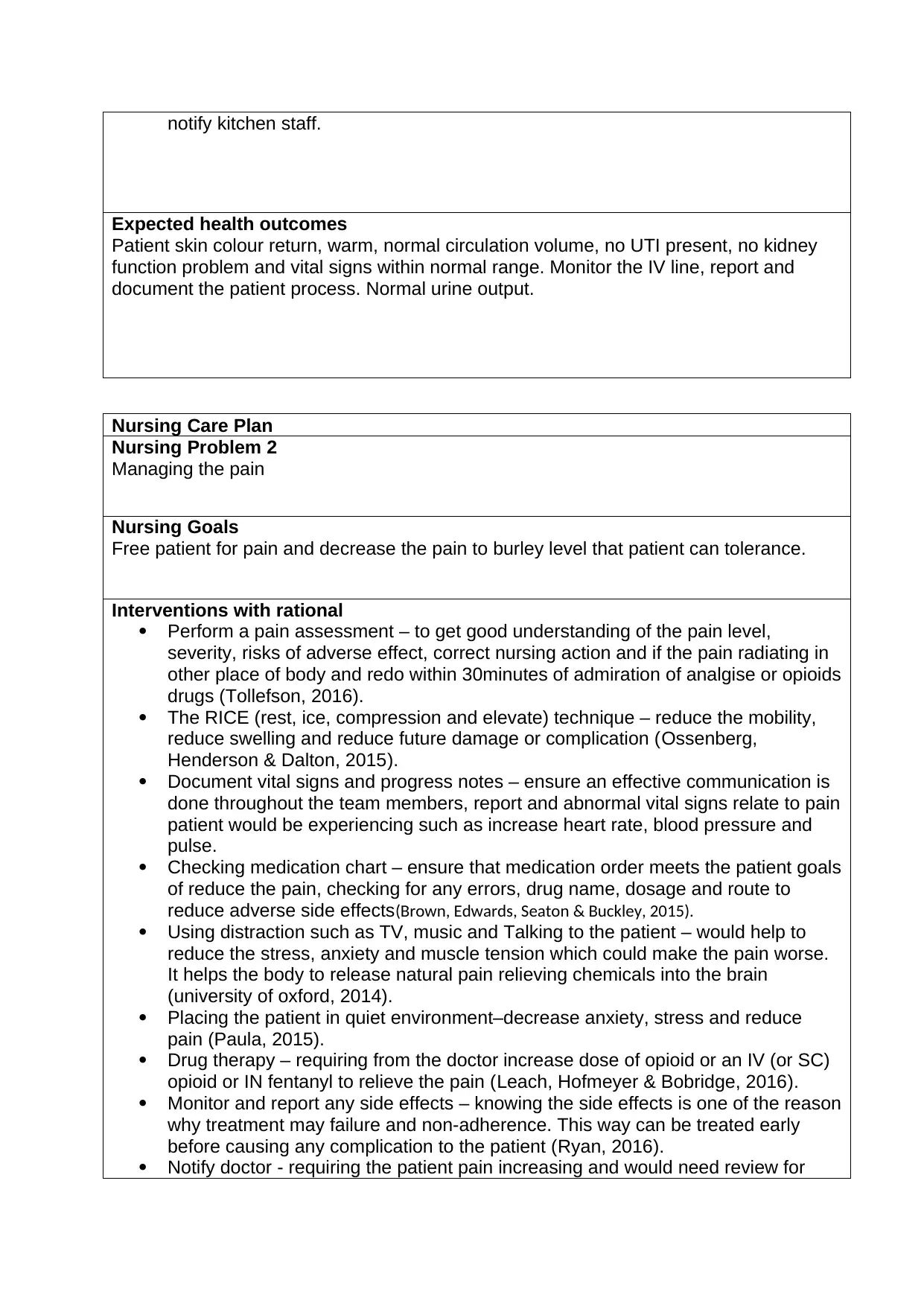
notify kitchen staff.
Expected health outcomes
Patient skin colour return, warm, normal circulation volume, no UTI present, no kidney
function problem and vital signs within normal range. Monitor the IV line, report and
document the patient process. Normal urine output.
Nursing Care Plan
Nursing Problem 2
Managing the pain
Nursing Goals
Free patient for pain and decrease the pain to burley level that patient can tolerance.
Interventions with rational
Perform a pain assessment – to get good understanding of the pain level,
severity, risks of adverse effect, correct nursing action and if the pain radiating in
other place of body and redo within 30minutes of admiration of analgise or opioids
drugs (Tollefson, 2016).
The RICE (rest, ice, compression and elevate) technique – reduce the mobility,
reduce swelling and reduce future damage or complication (Ossenberg,
Henderson & Dalton, 2015).
Document vital signs and progress notes – ensure an effective communication is
done throughout the team members, report and abnormal vital signs relate to pain
patient would be experiencing such as increase heart rate, blood pressure and
pulse.
Checking medication chart – ensure that medication order meets the patient goals
of reduce the pain, checking for any errors, drug name, dosage and route to
reduce adverse side effects(Brown, Edwards, Seaton & Buckley, 2015).
Using distraction such as TV, music and Talking to the patient – would help to
reduce the stress, anxiety and muscle tension which could make the pain worse.
It helps the body to release natural pain relieving chemicals into the brain
(university of oxford, 2014).
Placing the patient in quiet environment–decrease anxiety, stress and reduce
pain (Paula, 2015).
Drug therapy – requiring from the doctor increase dose of opioid or an IV (or SC)
opioid or IN fentanyl to relieve the pain (Leach, Hofmeyer & Bobridge, 2016).
Monitor and report any side effects – knowing the side effects is one of the reason
why treatment may failure and non-adherence. This way can be treated early
before causing any complication to the patient (Ryan, 2016).
Notify doctor - requiring the patient pain increasing and would need review for
Expected health outcomes
Patient skin colour return, warm, normal circulation volume, no UTI present, no kidney
function problem and vital signs within normal range. Monitor the IV line, report and
document the patient process. Normal urine output.
Nursing Care Plan
Nursing Problem 2
Managing the pain
Nursing Goals
Free patient for pain and decrease the pain to burley level that patient can tolerance.
Interventions with rational
Perform a pain assessment – to get good understanding of the pain level,
severity, risks of adverse effect, correct nursing action and if the pain radiating in
other place of body and redo within 30minutes of admiration of analgise or opioids
drugs (Tollefson, 2016).
The RICE (rest, ice, compression and elevate) technique – reduce the mobility,
reduce swelling and reduce future damage or complication (Ossenberg,
Henderson & Dalton, 2015).
Document vital signs and progress notes – ensure an effective communication is
done throughout the team members, report and abnormal vital signs relate to pain
patient would be experiencing such as increase heart rate, blood pressure and
pulse.
Checking medication chart – ensure that medication order meets the patient goals
of reduce the pain, checking for any errors, drug name, dosage and route to
reduce adverse side effects(Brown, Edwards, Seaton & Buckley, 2015).
Using distraction such as TV, music and Talking to the patient – would help to
reduce the stress, anxiety and muscle tension which could make the pain worse.
It helps the body to release natural pain relieving chemicals into the brain
(university of oxford, 2014).
Placing the patient in quiet environment–decrease anxiety, stress and reduce
pain (Paula, 2015).
Drug therapy – requiring from the doctor increase dose of opioid or an IV (or SC)
opioid or IN fentanyl to relieve the pain (Leach, Hofmeyer & Bobridge, 2016).
Monitor and report any side effects – knowing the side effects is one of the reason
why treatment may failure and non-adherence. This way can be treated early
before causing any complication to the patient (Ryan, 2016).
Notify doctor - requiring the patient pain increasing and would need review for
⊘ This is a preview!⊘
Do you want full access?
Subscribe today to unlock all pages.

Trusted by 1+ million students worldwide
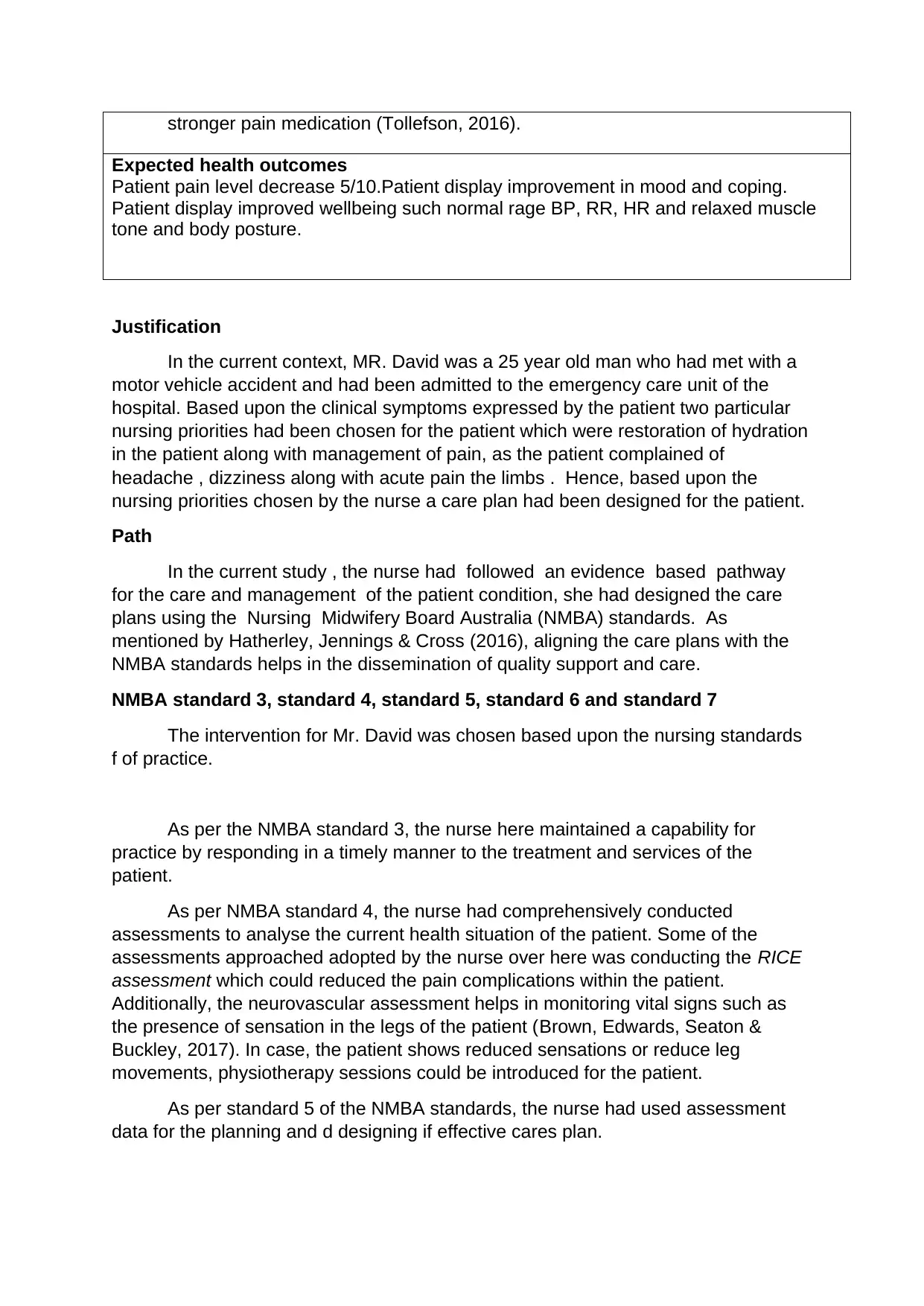
stronger pain medication (Tollefson, 2016).
Expected health outcomes
Patient pain level decrease 5/10.Patient display improvement in mood and coping.
Patient display improved wellbeing such normal rage BP, RR, HR and relaxed muscle
tone and body posture.
Justification
In the current context, MR. David was a 25 year old man who had met with a
motor vehicle accident and had been admitted to the emergency care unit of the
hospital. Based upon the clinical symptoms expressed by the patient two particular
nursing priorities had been chosen for the patient which were restoration of hydration
in the patient along with management of pain, as the patient complained of
headache , dizziness along with acute pain the limbs . Hence, based upon the
nursing priorities chosen by the nurse a care plan had been designed for the patient.
Path
In the current study , the nurse had followed an evidence based pathway
for the care and management of the patient condition, she had designed the care
plans using the Nursing Midwifery Board Australia (NMBA) standards. As
mentioned by Hatherley, Jennings & Cross (2016), aligning the care plans with the
NMBA standards helps in the dissemination of quality support and care.
NMBA standard 3, standard 4, standard 5, standard 6 and standard 7
The intervention for Mr. David was chosen based upon the nursing standards
f of practice.
As per the NMBA standard 3, the nurse here maintained a capability for
practice by responding in a timely manner to the treatment and services of the
patient.
As per NMBA standard 4, the nurse had comprehensively conducted
assessments to analyse the current health situation of the patient. Some of the
assessments approached adopted by the nurse over here was conducting the RICE
assessment which could reduced the pain complications within the patient.
Additionally, the neurovascular assessment helps in monitoring vital signs such as
the presence of sensation in the legs of the patient (Brown, Edwards, Seaton &
Buckley, 2017). In case, the patient shows reduced sensations or reduce leg
movements, physiotherapy sessions could be introduced for the patient.
As per standard 5 of the NMBA standards, the nurse had used assessment
data for the planning and d designing if effective cares plan.
Expected health outcomes
Patient pain level decrease 5/10.Patient display improvement in mood and coping.
Patient display improved wellbeing such normal rage BP, RR, HR and relaxed muscle
tone and body posture.
Justification
In the current context, MR. David was a 25 year old man who had met with a
motor vehicle accident and had been admitted to the emergency care unit of the
hospital. Based upon the clinical symptoms expressed by the patient two particular
nursing priorities had been chosen for the patient which were restoration of hydration
in the patient along with management of pain, as the patient complained of
headache , dizziness along with acute pain the limbs . Hence, based upon the
nursing priorities chosen by the nurse a care plan had been designed for the patient.
Path
In the current study , the nurse had followed an evidence based pathway
for the care and management of the patient condition, she had designed the care
plans using the Nursing Midwifery Board Australia (NMBA) standards. As
mentioned by Hatherley, Jennings & Cross (2016), aligning the care plans with the
NMBA standards helps in the dissemination of quality support and care.
NMBA standard 3, standard 4, standard 5, standard 6 and standard 7
The intervention for Mr. David was chosen based upon the nursing standards
f of practice.
As per the NMBA standard 3, the nurse here maintained a capability for
practice by responding in a timely manner to the treatment and services of the
patient.
As per NMBA standard 4, the nurse had comprehensively conducted
assessments to analyse the current health situation of the patient. Some of the
assessments approached adopted by the nurse over here was conducting the RICE
assessment which could reduced the pain complications within the patient.
Additionally, the neurovascular assessment helps in monitoring vital signs such as
the presence of sensation in the legs of the patient (Brown, Edwards, Seaton &
Buckley, 2017). In case, the patient shows reduced sensations or reduce leg
movements, physiotherapy sessions could be introduced for the patient.
As per standard 5 of the NMBA standards, the nurse had used assessment
data for the planning and d designing if effective cares plan.
Paraphrase This Document
Need a fresh take? Get an instant paraphrase of this document with our AI Paraphraser
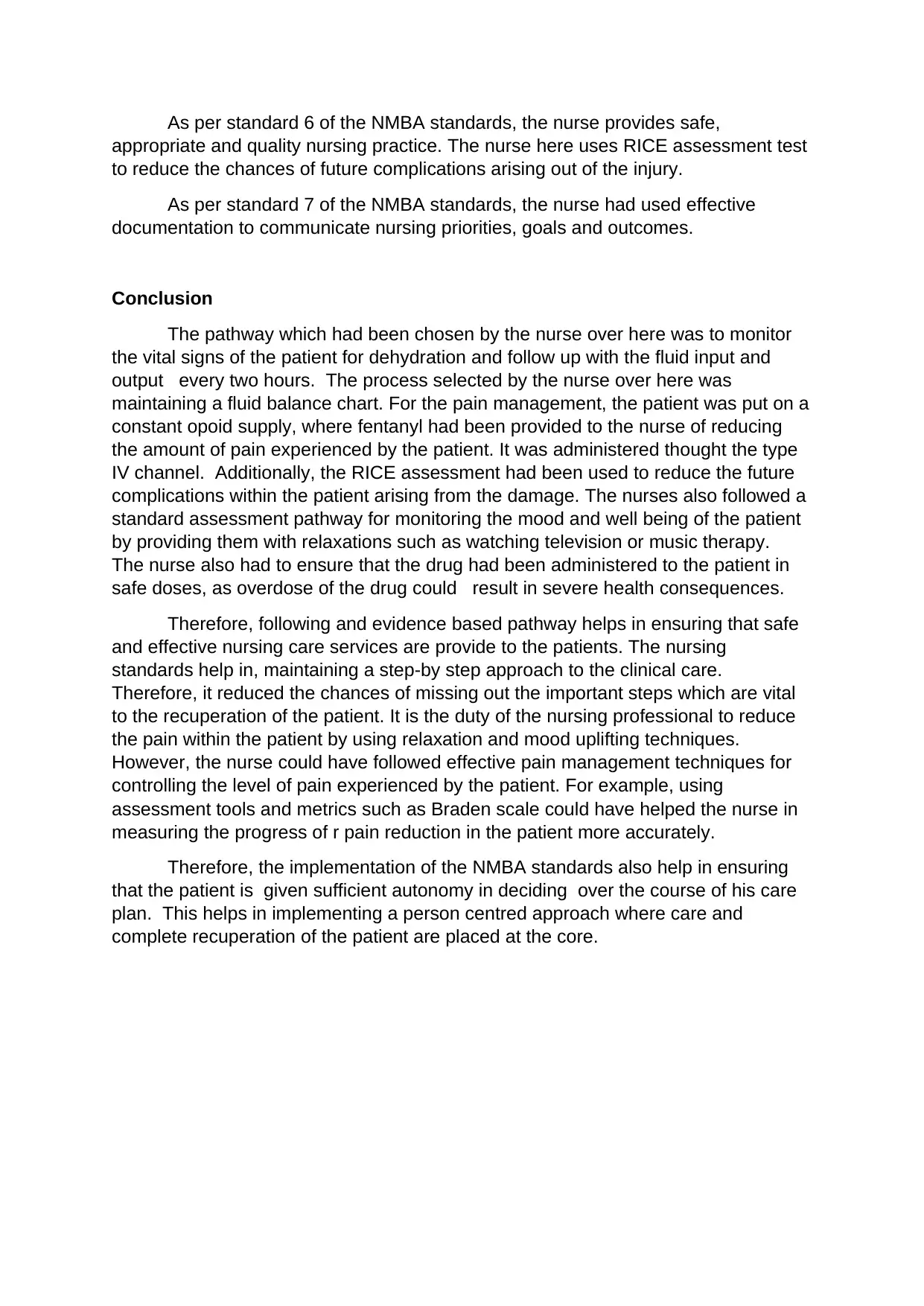
As per standard 6 of the NMBA standards, the nurse provides safe,
appropriate and quality nursing practice. The nurse here uses RICE assessment test
to reduce the chances of future complications arising out of the injury.
As per standard 7 of the NMBA standards, the nurse had used effective
documentation to communicate nursing priorities, goals and outcomes.
Conclusion
The pathway which had been chosen by the nurse over here was to monitor
the vital signs of the patient for dehydration and follow up with the fluid input and
output every two hours. The process selected by the nurse over here was
maintaining a fluid balance chart. For the pain management, the patient was put on a
constant opoid supply, where fentanyl had been provided to the nurse of reducing
the amount of pain experienced by the patient. It was administered thought the type
IV channel. Additionally, the RICE assessment had been used to reduce the future
complications within the patient arising from the damage. The nurses also followed a
standard assessment pathway for monitoring the mood and well being of the patient
by providing them with relaxations such as watching television or music therapy.
The nurse also had to ensure that the drug had been administered to the patient in
safe doses, as overdose of the drug could result in severe health consequences.
Therefore, following and evidence based pathway helps in ensuring that safe
and effective nursing care services are provide to the patients. The nursing
standards help in, maintaining a step-by step approach to the clinical care.
Therefore, it reduced the chances of missing out the important steps which are vital
to the recuperation of the patient. It is the duty of the nursing professional to reduce
the pain within the patient by using relaxation and mood uplifting techniques.
However, the nurse could have followed effective pain management techniques for
controlling the level of pain experienced by the patient. For example, using
assessment tools and metrics such as Braden scale could have helped the nurse in
measuring the progress of r pain reduction in the patient more accurately.
Therefore, the implementation of the NMBA standards also help in ensuring
that the patient is given sufficient autonomy in deciding over the course of his care
plan. This helps in implementing a person centred approach where care and
complete recuperation of the patient are placed at the core.
appropriate and quality nursing practice. The nurse here uses RICE assessment test
to reduce the chances of future complications arising out of the injury.
As per standard 7 of the NMBA standards, the nurse had used effective
documentation to communicate nursing priorities, goals and outcomes.
Conclusion
The pathway which had been chosen by the nurse over here was to monitor
the vital signs of the patient for dehydration and follow up with the fluid input and
output every two hours. The process selected by the nurse over here was
maintaining a fluid balance chart. For the pain management, the patient was put on a
constant opoid supply, where fentanyl had been provided to the nurse of reducing
the amount of pain experienced by the patient. It was administered thought the type
IV channel. Additionally, the RICE assessment had been used to reduce the future
complications within the patient arising from the damage. The nurses also followed a
standard assessment pathway for monitoring the mood and well being of the patient
by providing them with relaxations such as watching television or music therapy.
The nurse also had to ensure that the drug had been administered to the patient in
safe doses, as overdose of the drug could result in severe health consequences.
Therefore, following and evidence based pathway helps in ensuring that safe
and effective nursing care services are provide to the patients. The nursing
standards help in, maintaining a step-by step approach to the clinical care.
Therefore, it reduced the chances of missing out the important steps which are vital
to the recuperation of the patient. It is the duty of the nursing professional to reduce
the pain within the patient by using relaxation and mood uplifting techniques.
However, the nurse could have followed effective pain management techniques for
controlling the level of pain experienced by the patient. For example, using
assessment tools and metrics such as Braden scale could have helped the nurse in
measuring the progress of r pain reduction in the patient more accurately.
Therefore, the implementation of the NMBA standards also help in ensuring
that the patient is given sufficient autonomy in deciding over the course of his care
plan. This helps in implementing a person centred approach where care and
complete recuperation of the patient are placed at the core.
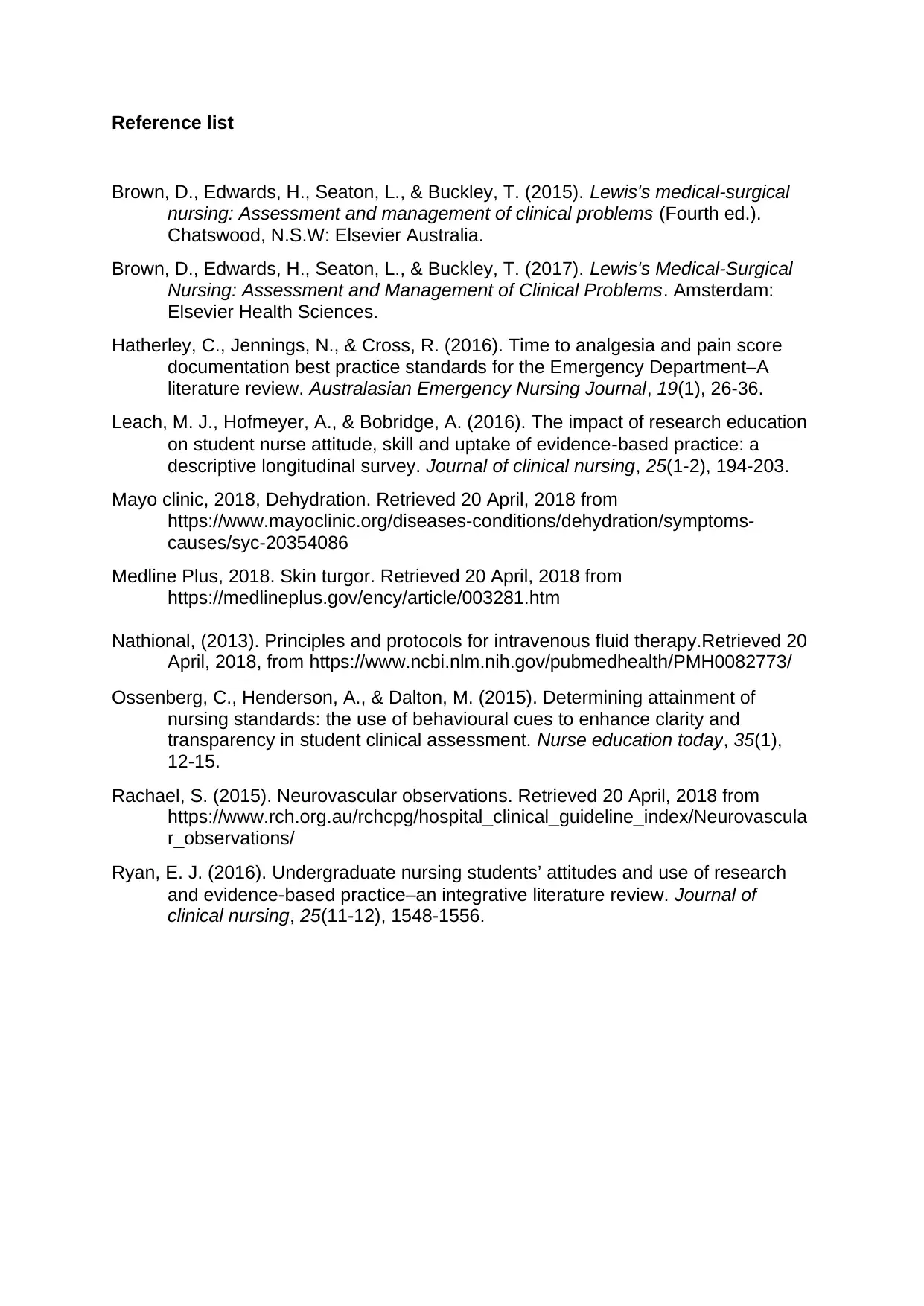
Reference list
Brown, D., Edwards, H., Seaton, L., & Buckley, T. (2015). Lewis's medical-surgical
nursing: Assessment and management of clinical problems (Fourth ed.).
Chatswood, N.S.W: Elsevier Australia.
Brown, D., Edwards, H., Seaton, L., & Buckley, T. (2017). Lewis's Medical-Surgical
Nursing: Assessment and Management of Clinical Problems. Amsterdam:
Elsevier Health Sciences.
Hatherley, C., Jennings, N., & Cross, R. (2016). Time to analgesia and pain score
documentation best practice standards for the Emergency Department–A
literature review. Australasian Emergency Nursing Journal, 19(1), 26-36.
Leach, M. J., Hofmeyer, A., & Bobridge, A. (2016). The impact of research education
on student nurse attitude, skill and uptake of evidence‐based practice: a
descriptive longitudinal survey. Journal of clinical nursing, 25(1-2), 194-203.
Mayo clinic, 2018, Dehydration. Retrieved 20 April, 2018 from
https://www.mayoclinic.org/diseases-conditions/dehydration/symptoms-
causes/syc-20354086
Medline Plus, 2018. Skin turgor. Retrieved 20 April, 2018 from
https://medlineplus.gov/ency/article/003281.htm
Nathional, (2013). Principles and protocols for intravenous fluid therapy.Retrieved 20
April, 2018, from https://www.ncbi.nlm.nih.gov/pubmedhealth/PMH0082773/
Ossenberg, C., Henderson, A., & Dalton, M. (2015). Determining attainment of
nursing standards: the use of behavioural cues to enhance clarity and
transparency in student clinical assessment. Nurse education today, 35(1),
12-15.
Rachael, S. (2015). Neurovascular observations. Retrieved 20 April, 2018 from
https://www.rch.org.au/rchcpg/hospital_clinical_guideline_index/Neurovascula
r_observations/
Ryan, E. J. (2016). Undergraduate nursing students’ attitudes and use of research
and evidence‐based practice–an integrative literature review. Journal of
clinical nursing, 25(11-12), 1548-1556.
Brown, D., Edwards, H., Seaton, L., & Buckley, T. (2015). Lewis's medical-surgical
nursing: Assessment and management of clinical problems (Fourth ed.).
Chatswood, N.S.W: Elsevier Australia.
Brown, D., Edwards, H., Seaton, L., & Buckley, T. (2017). Lewis's Medical-Surgical
Nursing: Assessment and Management of Clinical Problems. Amsterdam:
Elsevier Health Sciences.
Hatherley, C., Jennings, N., & Cross, R. (2016). Time to analgesia and pain score
documentation best practice standards for the Emergency Department–A
literature review. Australasian Emergency Nursing Journal, 19(1), 26-36.
Leach, M. J., Hofmeyer, A., & Bobridge, A. (2016). The impact of research education
on student nurse attitude, skill and uptake of evidence‐based practice: a
descriptive longitudinal survey. Journal of clinical nursing, 25(1-2), 194-203.
Mayo clinic, 2018, Dehydration. Retrieved 20 April, 2018 from
https://www.mayoclinic.org/diseases-conditions/dehydration/symptoms-
causes/syc-20354086
Medline Plus, 2018. Skin turgor. Retrieved 20 April, 2018 from
https://medlineplus.gov/ency/article/003281.htm
Nathional, (2013). Principles and protocols for intravenous fluid therapy.Retrieved 20
April, 2018, from https://www.ncbi.nlm.nih.gov/pubmedhealth/PMH0082773/
Ossenberg, C., Henderson, A., & Dalton, M. (2015). Determining attainment of
nursing standards: the use of behavioural cues to enhance clarity and
transparency in student clinical assessment. Nurse education today, 35(1),
12-15.
Rachael, S. (2015). Neurovascular observations. Retrieved 20 April, 2018 from
https://www.rch.org.au/rchcpg/hospital_clinical_guideline_index/Neurovascula
r_observations/
Ryan, E. J. (2016). Undergraduate nursing students’ attitudes and use of research
and evidence‐based practice–an integrative literature review. Journal of
clinical nursing, 25(11-12), 1548-1556.
⊘ This is a preview!⊘
Do you want full access?
Subscribe today to unlock all pages.

Trusted by 1+ million students worldwide
1 out of 6
Related Documents
Your All-in-One AI-Powered Toolkit for Academic Success.
+13062052269
info@desklib.com
Available 24*7 on WhatsApp / Email
![[object Object]](/_next/static/media/star-bottom.7253800d.svg)
Unlock your academic potential
Copyright © 2020–2025 A2Z Services. All Rights Reserved. Developed and managed by ZUCOL.





